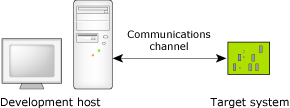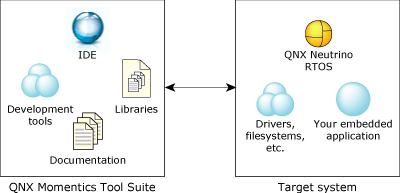![[Previous]](prev.gif) |
![[Contents]](contents.gif) |
![[Index]](keyword_index.gif) |
![[Next]](next.gif) |
![[Previous]](prev.gif) |
![[Contents]](contents.gif) |
![[Index]](keyword_index.gif) |
![[Next]](next.gif) |
This chapter includes:
Thank you for choosing the QNX Software Development Platform. It includes everything you need to build and maintain your QNX Neutrino-based embedded system:
We now invite you to explore the advanced tools that the QNX Momentics Tool Suite adds to QNX Neutrino.
As a complete package designed for embedded systems developers, the QNX Software Development Platform gives you everything you need at every stage of your product-development cycle:
Full source code for numerous startup programs, IPLs, device drivers, etc. is available from our website.
You can install QNX SDP on a QNX Neutrino system for self-hosted development, or you can install it on a Windows or Linux development host and install QNX Neutrino on a target system:

Development host and target system.
The development host runs the QNX Momentics Tool Suite; the target system runs the QNX Neutrino RTOS itself plus all the programs you develop:

QNX Momentics is the development environment on your host for the QNX Neutrino RTOS running on your target.
If the QNX Neutrino RTOS is the “engine” that will empower the embedded system you're developing, then QNX Momentics is the “factory” where you modify your engine as well as build, test, and finish your vehicles.
Here are the main parts of the QNX Momentics Tool Suite:
Once you've installed the QNX Software Development Platform, you can download these components from our website (http://www.qnx.com/) after logging into your myQNX account:
Note that the QNX Software Development Platform includes the DDK documentation.
The QNX Aviage brand encompasses a portfolio of middleware products that help you create consumer-grade audio, video, and graphical products in record time. QNX Aviage software products accelerate your innovation by offering the following:
For more information about QNX Aviage middleware, contact your sales representative.
Assuming you plan to develop a Neutrino-based embedded system of some kind (e.g. a vehicle telematics system, a router, a medical imaging device), you can start developing your application, even before you have your target hardware.
And if you haven't yet decided on the CPU family for your target (e.g. PowerPC, XScale), you can still begin developing your application. As a rule, with QNX Momentics you write your application code once, then compile it however many times you need for whatever supported targets you're using. As you'll see if you plan to use the IDE, you can build the very same project for any of our supported processors with just a couple of mouse clicks.
If you're developing on a self-hosted Neutrino system, you can run your application directly on your development machine.
Consider the following scenarios:
If your final target hardware will be a PC in some shape or form (e.g. a PC/104 SBC module), you can simply connect your host to any spare PC and use that as your temporary target. You should expect to make very few changes (if any) in your application when the time comes to move to your final target.
And if you don't happen to have a spare PC, you could use a virtual machine — products such as VMware Workstation and VMware Player (http://www.vmware.com), and Microsoft VirtualPC 2007 can emulate a separate, complete hardware environment right on your desktop.
Once you've set up a virtual machine (VM) on your host, you can then use it as your target — you can run, test, and debug your Neutrino applications on the VM as if it were an actual machine connected to your host.
 |
Virtual machines don't necessarily support hard realtime. |
In this case, the target computer (e.g. an LX800) isn't a PC. It doesn't have a BIOS, so it won't boot and load Neutrino in the same way as a PC. In order to run Neutrino on such a target, you need an appropriate BSP for your particular hardware, including an IPL that could set up the processor and load Neutrino properly.
 |
We're continually adding new BSPs to our extensive selection; for a list, see the Products area of our website, http://www.qnx.com. If you don't see a BSP for your target hardware, contact us. |
You can develop your application without target hardware, because much of your code will be hardware-independent. For device drivers and other hardware-specific areas of your system, you may be able to use a virtual platform tool that accurately emulates your specific embedded system hardware.
For instance, Virtio (http://www.virtio.com) makes virtual platforms that emulate various processors and peripherals, right down to the CPU's instruction set. You can download a free time-limited evaluation copy from the vendor's website.
Whatever your target hardware, you can still go a long way down your development path using QNX Momentics right now. Develop all your application-level components first, leaving device drivers and other hardware-specific details until you have your target hardware.
As mentioned earlier, you might want to consider Virtio if you need a functionally accurate virtual prototype of your embedded platform before you have the actual hardware itself.
Whatever the specific CPU family, your application code will, in most cases, run unchanged when you go to your final target. But you may need to be aware of a few platform-related issues (e.g. endian differences, CPU speeds, I/O addressing, alignment of data structures, memory limitations, synchronization on multicore vs uniprocessor systems, etc.).
Fortunately, QNX Momentics includes several header files and convenience functions that will help you anticipate and easily handle such problems.
 |
For more information on these and other platform-related issues, see Freedom from Hardware and Platform Dependencies in the Neutrino Programmer's Guide. |
There are several QNX Development License streams that govern how the QNX Software Development Platform (“QNX SDP”) can be used in different situations. The key on your license certificate will cause the appropriate license agreement to be displayed when you install the QNX SDP; that development license governs your use of the product.
Once you've installed QNX SDP, you'll find a copy of all the license agreements in base_dir/install/qnxsdp/6.5.0, where base_dir is where you installed QNX SDP.
For more information about licensing, visit the Licensing area of http://www.qnx.com, where you'll find details on our licensing model, types of licenses, etc., or email licensing@qnx.com.
![[Previous]](prev.gif) |
![[Contents]](contents.gif) |
![[Index]](keyword_index.gif) |
![[Next]](next.gif) |